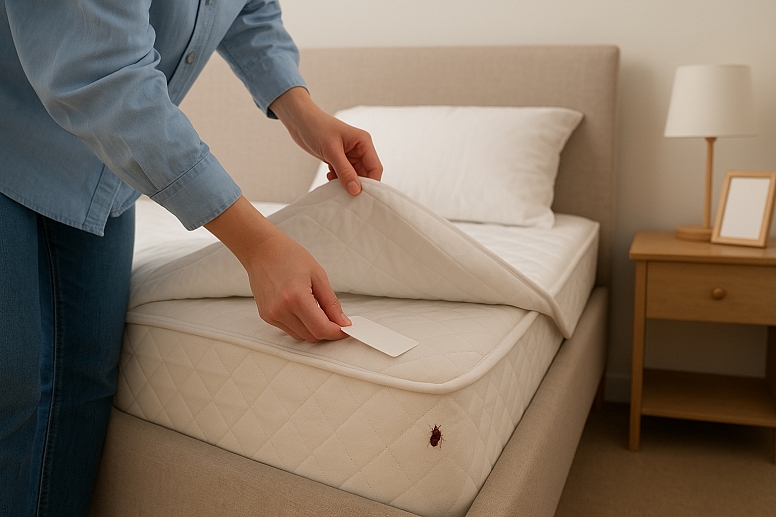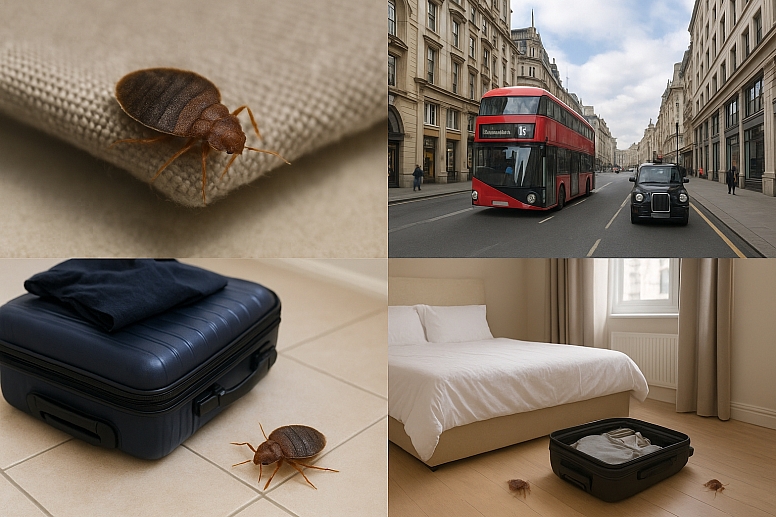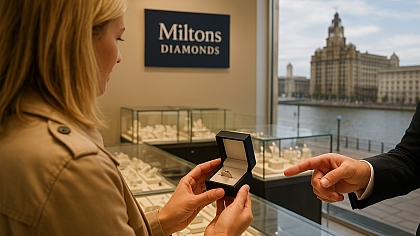
Bed Bug Treatment Tips for Everyday Home Protection
You’ve found a couple of itchy bites and now every crease in the sofa feels suspicious. Before panic sets in, remember that learning a few practical, science-based tricks goes a long way toward keeping bed bugs from settling in.
While you read, keep bedbugspecialist.co.uk open for quick reference photos of signs and stages—seeing what to look for will make each step here far easier than guessing in the dark later.
Detect Early Warning Signs
Staying ahead of bedbugs begins with noticing subtle clues before populations explode and spread. Treat detection like a weekly safety drill rather than a chore reluctantly postponed.
Check When Changing Sheets
While stripping linens, look for pepper-like droppings, pale shell casings, or rust-colored smears on seams and piping that betray nighttime feeding activity.
Inspect Nearby Furniture Crevices
Bedbugs hide in nightstands, picture frames, and headboards no thicker than a credit card, so tilt and tap furnishings, catching offenders on sticky white paper.
Use Flashlight and Credit Card Tool
A bright LED and a thin card reveal insects shoved deep into tufts and screw holes. Work methodically from the headboard outward, marking suspect areas with tape.
Document Findings Immediately
Snap photos and record dates to track hot spots. Consistent documentation clarifies whether interventions succeed or colonies migrate elsewhere within the home.
Verify Active Bedbugs
False alarms waste time, so confirm that living bedbugs exist before launching drastic treatments. Distinguish between earlier infestations and currently feeding insects with deliberate tests.
- Install interceptors under each bed leg; living bedbugs climb in overnight, proving active movement toward hosts rather than historic evidence alone.
- Deploy CO₂ traps that mimic sleeping breath; fresh captures by morning remove any doubt about ongoing reproductive populations needing immediate control.
- Check for fresh fecal spots by wiping seams with wet cotton; new dark smears dissolve, whereas old stains remain fixed and faded.
- Look for moving nymphs smaller than sesame seeds; their translucent bodies indicate recent hatchings, spotlighting a thriving life cycle demanding rapid response.
After confirmation, act decisively. Early verified activity prevents genetic resistance from chronic low-dose pesticide exposure and saves furniture that later might require disposal.
Visual Bedbug Characteristics
Recognizing the pest’s appearance prevents misidentifying carpet beetles or fleas. Compare actual specimens to authoritative images rather than relying on memory distorted by stress.
Shape and Color
Adults resemble apple seeds—oval, flattened, and mahogany until engorged, when they swell into elongated, reddish balloons easily visible against light fabrics.
Life-Stage Differences
Nymphs progress through five instars, each shed skin slightly larger. Early instars are clear, becoming amber, then brown. All stages possess the same six-leg silhouette.
Antennae and Eyes
Under magnification, two segmented antennae angle forward, and simple compound eyes sit laterally. The absence of wings distinguishes them from similar-sized cockroach nymphs.
Common Infestation Indicators
Many homeowners notice peripheral signs before spotting the insects themselves. Tracking these indicators builds a compelling case for professional or DIY interventions without unnecessary delay.
- Odor of coriander released by alarm pheromones, especially strong in closets or behind baseboards where clusters gather undisturbed.
- Linear bite patterns on arms, neck, or legs, popularly labeled “breakfast, lunch, dinner,” although reactions vary among individuals.
- Blood specks on pillowcases from crushed, engorged bugs during sleep, often adjacent to tiny black excrement dots.
- Casting piles of discarded skins in mattress tags and electrical outlets, signaling multiple molt cycles have already passed inside the room.
Cataloging at least two independent indicators strengthens diagnosis accuracy and mobilizes household members toward unified eradication efforts without complacent skepticism.
Typical Spread Pathways

Understanding how bedbugs travel arms you to close entry points and reduce accidental pickups during everyday routines at work, school, or vacation.
Urban Hotspot Awareness
In dense metropolitan areas like London, bedbug infestations often spread quickly through hotels, public transport, and multi-unit housing. High turnover of residents and frequent international travel make the city especially vulnerable to recurring outbreaks. Regular inspections in rental properties, student accommodations, and public facilities are essential to detect early warning signs before pests migrate between neighboring units. Local pest control services familiar with urban building layouts can provide tailored strategies to contain and eliminate infestations efficiently.
Luggage and Travel Gear
The majority of home infestations originate from hitchhikers in suitcases. Store bags in hotel bathtubs during trips and quarantine upon returning home for inspection.
Used Furniture and Clothing
Thrift bargains carry hidden costs. Whenever possible, heat-treat, steam, or isolate secondhand items for a week before bringing them indoors.
Shared Laundry Facilities
Bedbugs crawl between washers, hampers, and folding tables. Transport clothes in sealed bags and immediately dry on high heat to kill any contaminants.
Multi-Unit Building Migration
In apartments, pests move through wall voids, plumbing, and electrical conduits. Door sweeps and outlet dusting help hinder cross-unit expansion.
Preventive Daily Habits
Consistent routines create an environment where bedbugs struggle to establish harborages. Incorporate the following habits into normal housekeeping without devoting entire weekends to pest patrol.
- Launder bedding weekly using hot water above 120°F, followed by at least thirty minutes on the dryer’s highest setting.
- Vacuum thoroughly around mattress edges, baseboards, and upholstery seams, then seal and discard vacuum bags outdoors to avoid reinfestation.
- Declutter floors so stray clothing or books do not become undisturbed shelters that allow populations to multiply undetected.
- Elevate beds away from walls, eliminating convenient bridges for crawling pests to reach sleepers during the night.
By embedding these manageable tasks into daily life, households build a robust preventive shield without the expense of repeated large-scale extermination campaigns.
Contain Current Infestation
Once treatment begins, disciplined follow-through ensures chemicals, heat, or steam reach every last egg. Professional protocols highlight three critical post-service responsibilities for residents.
Follow Ventilation Guidelines
Open windows for several hours after pesticide application, letting airborne residues disperse and surfaces dry, protecting pets, children, and respiratory health.
Observe Re-Entry Timing
Respect the technician’s specified interval before occupying rooms again; premature return compromises effectiveness and exposes occupants unnecessarily.
Launder and Heat-Treat Fabrics
Wash curtains, clothing, and plush toys immediately, then dry on maximum heat; this kills survivors fleeing treated zones seeking untreated textile refuge.
Effective Bedbug Elimination
Combining multiple control tools prevents resistance and maximizes kill rates. Integrated pest management treats the problem as a system rather than a single-method gamble.
High-Heat Whole-Room Services
Professional heaters raise air temperatures above 130°F, lethal at every life stage. Remove candles, aerosols, and electronics sensitive to sustained heat before scheduling.
Residual Insecticides
Modern low-odor formulations linger on cracks and furniture joints for weeks, catching late-hatching nymphs that escaped initial exposure.
Targeted Steam Treatments
Commercial steamers penetrate fabrics and box springs instantly, an excellent non-chemical choice for allergy-sensitive homes or crib mattresses.
Desiccant Dusts
Silica or diatomaceous powders abrade the waxy cuticle, dehydrating insects. Apply lightly inside wall voids and outlet plates where sprays cannot safely reach.
Install Protective Encasements
Sealing mattresses and box springs denies hidden bugs both shelter and easy blood meals, cutting reproduction rates dramatically within a single generation.
- Select certified encasements labeled specifically for bedbug protection rather than generic allergy covers lacking bite-proof seams or locking zippers.
- Follow installation directions such as those from Bargoose Bedding to avoid tearing fabric or trapping sharp objects that compromise the barrier.
- Leave covers on for at least one full year; starving bedbugs cannot survive twelve months without feeding, guaranteeing eventual death inside.
- Inspect regularly for rips, loose stitching, or gum-clogged zipper tracks. Prompt repairs preserve integrity and prevent accidental escapes.
Combined with interceptor cups and diligent vacuuming, encasements form a three-tier defense that slashes chances of reinfestation after professional remediation.
Stay alert, act decisively, and combine vigilant cleaning with targeted treatments. Inspect seams, launder heat-safe fabrics, and isolate suspect items. When traveling, simple precautions help keep your luggage safe from hitchhikers. If DIY measures stall, involve professionals promptly to halt the cycle and protect your peace of mind and health.











